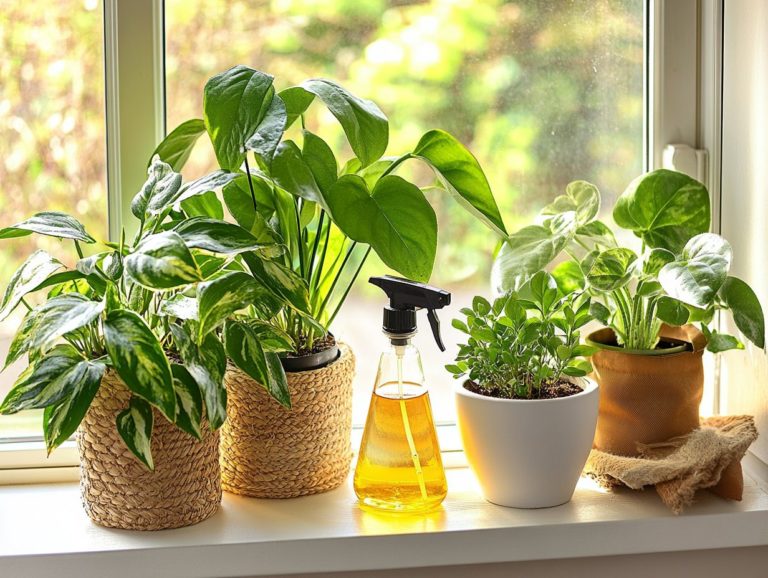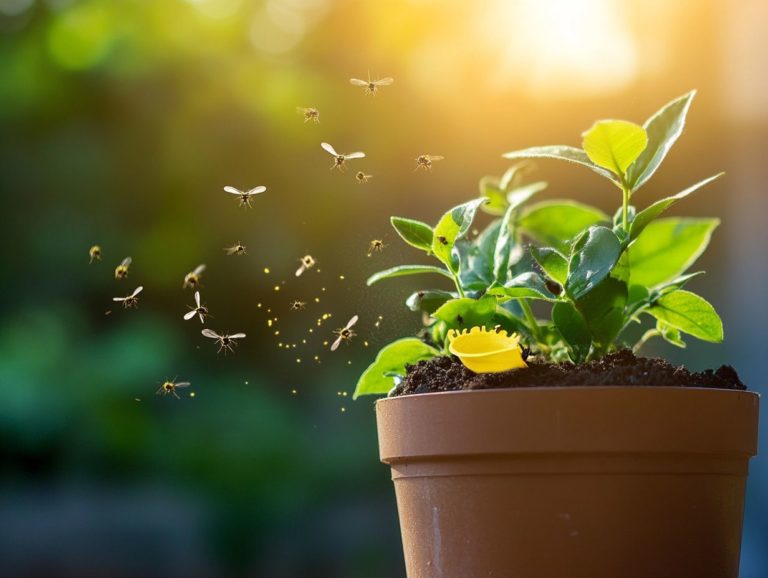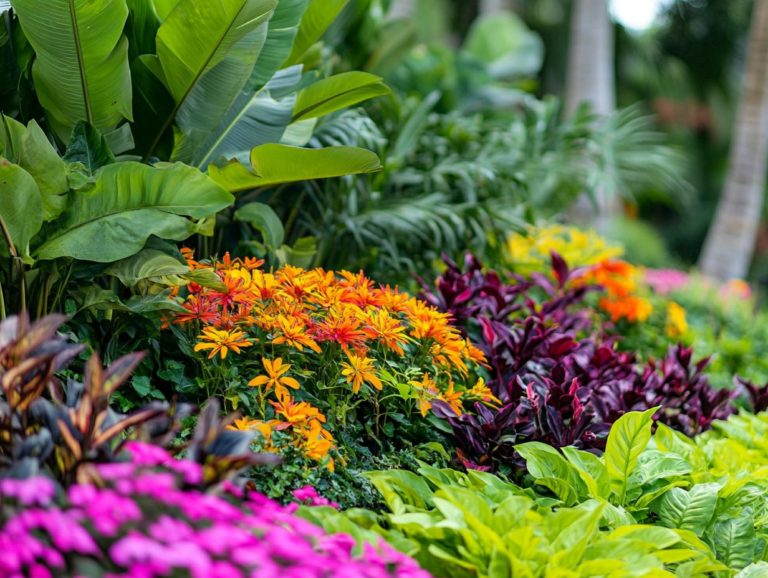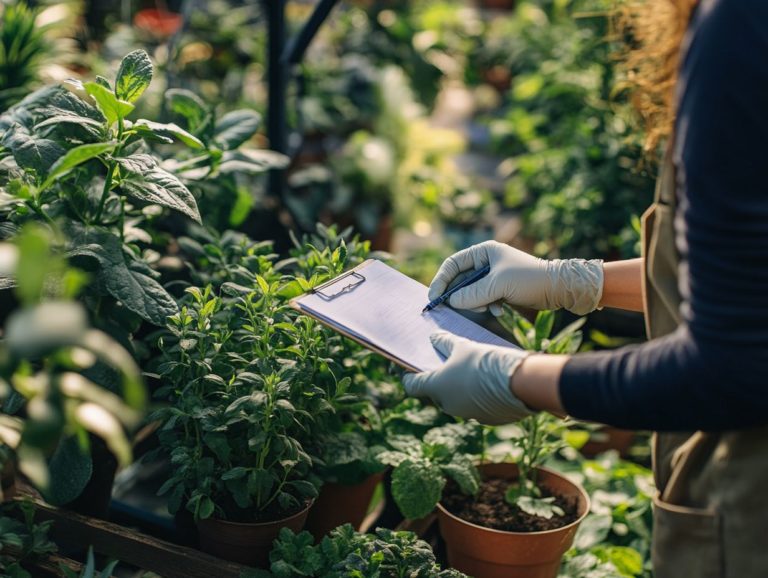Best Indoor Plants for Pest Control
Are annoying insects invading your indoor sanctuary? Are you looking for effective homemade pesticides to combat these issues?
Unleash the power of nature with this guide to the finest indoor plants for pest control. This guide features natural remedies that utilize household ingredients. From the invigorating scent of mint to the delightful aroma of rosemary, these plants not only enhance your home s aesthetic but also act as natural deterrents against unwanted visitors. Make them your ideal repellent plants.
Delve into the fascinating ways these plants function and the specific pests they target, including aphids and spider mites. Discover innovative methods to weave them into your living space. Bid farewell to harsh chemicals and welcome a greener, pest-free haven by utilizing homemade pesticides.
Contents
- Key Takeaways:
- 1. Mint
- 2. Lavender
- 3. Basil
- 4. Rosemary
- 5. Lemongrass
- 6. Chrysanthemums
- 7. Marigolds
- 8. Eucalyptus
- 9. Catnip
- 10. Citronella
- 11. Geraniums
- 12. Thyme
- 13. Petunias
- 14. Oregano
- 15. Sage
- What Makes These Plants Effective for Pest Control?
- Frequently Asked Questions
- What are the best indoor plants for pest control?
- How do these indoor plants help with pest control?
- Can these plants be grown indoors without much sunlight?
- Are these plants safe for pets and children?
- How often do these plants need to be watered?
- Can these plants be used as a sole method of pest control?
Key Takeaways:
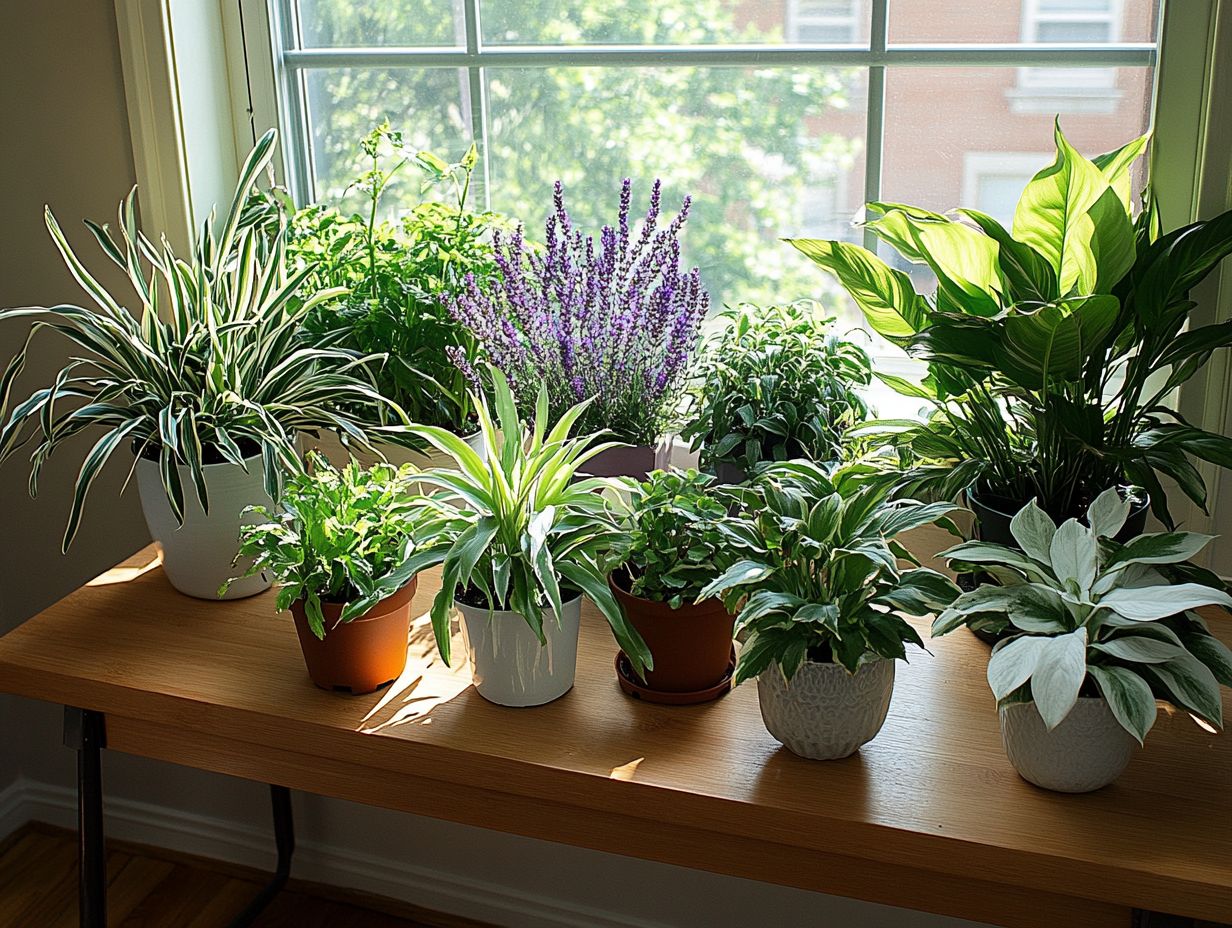
- Mint, lavender, and basil have natural oils that repel pests, making them great indoor plants for pest control, particularly effective against aphids and spider mites.
- These plants help control various pests, including flies, mosquitoes, and ants.
- To use these plants for pest control, place them near doorways, windows, or in areas where pests are commonly found, such as vegetable gardens.
1. Mint
Mint is a delightful herb that adds flavor to your cooking. It also serves as a potent homemade pesticide that effectively combats pests like aphids and spider mites on your houseplants, making it essential to your pest management arsenal.
This aromatic herb’s robust scent revitalizes your space and acts as a deterrent against various common pests. Watch your plants thrive without pests!
Crafting a mint-infused pesticide is simple:
- Steep fresh mint leaves in boiling water.
- Allow the mixture to cool.
- Strain the infusion and transfer it to a spray bottle.
To boost effectiveness, consider combining mint essential oil with natural ingredients like dishwashing liquid or vinegar for a better homemade pesticide solution. This fragrant ally integrates easily with other organic remedies, allowing you to take a holistic approach to pest control while keeping your plants and pets safe.
2. Lavender
Lavender is celebrated for its calming fragrance and its remarkable ability to repel pests. It naturally keeps nuisances like fungus gnats and mealybugs at bay from your cherished indoor plants.
The natural plant oils found in lavender, especially linalool and linalyl acetate, are key to its insect-repelling prowess. They form a barrier that insects find uninviting. To fully embrace its benefits, cultivate lavender in well-drained soil with plenty of sunlight to boost oil production.
Once the plants mature, you can dry the flowers for sachets or steep them in water to create an effective spray.
Regular pruning encourages vibrant blooms and maximizes the release of precious oils, making lavender invaluable in your journey toward sustainable pest management through natural insecticides.
3. Basil
Basil isn t just a popular herb; it s also a versatile ally in crafting homemade pesticides. Pair it with garlic spray or chili spray to bolster pest control for your houseplants.
With its natural oils and distinctive aroma, basil effectively repels various pests that might invade your urban garden. Its knack for keeping unwanted insects at bay makes it an excellent companion plant, creating a less inviting environment for infestations.
When combined with garlic renowned for its insect-repelling abilities due to its sulfur content this duo transforms into a remarkably effective garlic spray.
To whip up a simple garlic spray, just follow these steps:
- Blend a few cloves of garlic with water.
- Strain the mixture and add a dash of liquid soap.
This straightforward, eco-friendly solution keeps pests at bay and aligns seamlessly with sustainable gardening practices, fostering a healthier urban gardening ecosystem by using ingredients like diatomaceous earth.
4. Rosemary
Rosemary has aromatic leaves that serve two key purposes: as a flavorful seasoning and as a natural pest control ally. Its essential oils can repel unwanted insects from your houseplants.
Use rosemary’s essential oils as a homemade pesticide to effectively deter common pests like aphids, spider mites, and whiteflies. Just mix the oil with water and add a few drops of liquid soap to create a potent spray for affected plants.
This herb thrives in sunny environments with well-drained soil and needs minimal water. It s perfect for indoor gardening and pest control!
5. Lemongrass
Lemongrass is more than a fragrant herb that enhances your dishes; it s a powerful natural remedy for pest control, repelling common pests like mosquitoes and flies.
Cultivating lemongrass indoors is surprisingly simple. All it requires is a bit of sunlight and a well-draining potting mix, letting you grow it right on your kitchen windowsill or balcony.
Its essential oils are well-known for deterring mosquitoes and other pesky insects. To make an effective pest management solution, steep fresh chopped lemongrass in water for a few hours, strain, and use it as a natural repellent. You can also mix it with other household ingredients like vegetable oil to mist around your home and keep unwanted pests at bay.
6. Chrysanthemums
Chrysanthemums burst with color and serve as powerful natural insecticides. They can effectively control pests like aphids and mealybugs when paired with a natural powder that kills pests, known as diatomaceous earth.
Their impressive pest-fighting abilities come from natural compounds, particularly pyrethrins, which disrupt the nervous systems of insects. Incorporating these stunning plants into your best practices for indoor plant pest control strategy is essential for maintaining a healthy indoor ecosystem.
Chrysanthemums need plenty of sunlight, well-drained soil, and regular watering. By integrating these flowers among your indoor plants, you enhance the aesthetic appeal of your space while taking advantage of their pest-repelling properties.
7. Marigolds

Marigolds are a feast for the eyes with their vibrant colors, and they’re your secret weapon in the garden. These remarkable plants repel nematodes, aphids, whiteflies, and various beetles, making them essential for pest control.
To harness the power of marigolds, consider planting them alongside your vegetable or flower gardens. This companion planting technique not only beautifies your space but also strengthens its natural defenses.
Marigolds work well with other organic solutions, such as neem oil and diatomaceous earth, boosting their effectiveness against unwanted guests. By weaving these natural remedies into your gardening practices, you cultivate a holistic approach that promotes the health of your plants.
8. Eucalyptus
Eucalyptus is celebrated for its medicinal properties and invigorating scent. Its essential oils are a great natural remedy for pest control, keeping pests like aphids and spider mites at bay.
To create your own pest deterrent, combine a few drops of eucalyptus oil with water and mild dish soap. Spray this mixture on your plants to repel unwanted guests.
If you want to grow eucalyptus indoors, ensure it gets ample sunlight and well-drained soil. Regular watering is key, but be careful overwatering can cause root rot, a decay of plant roots that you want to avoid.
9. Catnip
Catnip isn t just for cats; it s also a strong natural remedy for pest control. It effectively keeps mosquitoes and flies away from your indoor plants.
Use its natural oils to make homemade pest control sprays. Steep dried catnip leaves in boiling water, let it cool, and pour it into a spray bottle. This solution is safe for your plants!
Growing catnip is easy; it thrives in well-drained soil and bright light with minimal maintenance. It s perfect for both novice and experienced gardeners looking to boost their pest management toolkit.
10. Citronella
Citronella is not just for candles; it s a powerful natural insecticide. It effectively repels mosquitoes and other pests from your indoor plants.
You can grow this plant indoors on sunny windowsills. If you want to make your own pest solutions, extracting citronella oil is simple and rewarding.
Crush the leaves and steep them in a neutral oil to capture its essence. Use this mixture to create a homemade spray with a refreshing scent that keeps pests away.
11. Geraniums
Geraniums dazzle with vibrant blooms and serve as natural pest control. Their aromatic essential oils effectively repel pests.
You can use these oils in your homemade pesticide. Steep the leaves in water or make a concentrated extract to create a spray that nurtures a healthier garden ecosystem.
To grow geraniums, provide well-drained soil and ample sunlight. With regular watering and fertilization, they ll thrive while protecting your plants from infestations.
12. Thyme
Thyme is a remarkable herb not just for cooking but also as a natural pest control solution. Its aroma effectively keeps pests like aphids and whiteflies at bay without harsh chemicals.
Incorporate thyme into your pest management strategies to deter unwanted insects. This low-growing herb can suppress weeds while offering a sanctuary for beneficial insects.
Thyme not only enhances the visual appeal of your garden but also contributes to a healthier ecosystem. It s an invaluable ally in your quest for a thriving, pest-free environment.
13. Petunias
Petunias are not just beautiful flowers that elevate the aesthetic of your garden; they also serve as effective repellent plants. Their fragrant blooms naturally ward off pests from your indoor plants.
These vibrant flowers are renowned for their ability to keep aphids, spider mites, and even whiteflies at bay. By strategically placing petunias among your houseplants or within a container garden, you can start cultivating a dynamic ecosystem that deters these pesky invaders. However, it’s also important to recognize the signs your indoor plant has pests to take action when necessary.
It supports the health of your neighboring plants and reduces the need for chemical pest control methods. This promotes a more sustainable and eco-friendly approach to indoor gardening. For those dealing with pests, using effective pesticides for indoor plant care can be beneficial. Integrating petunias into your space can transform it into a more harmonious and pest-resistant environment.
14. Oregano

Oregano isn t just a favorite in the kitchen; it also offers impressive pest control properties. This makes it an invaluable ally for your indoor plants as a natural remedy against various pests.
By tapping into the power of oregano, you can craft your own homemade pest control solutions that are both safe and effective. Extracting essential oil from the herb allows its potent compounds to act as a formidable deterrent against pesky invaders like aphids and spider mites. For more comprehensive strategies, check out this guide on how to create a pest-free indoor garden.
When diluted and sprayed on your affected plants, these natural remedies repel and even eliminate these nuisances without the need for harsh chemicals. Plus, the delightful aroma of oregano will infuse your home with a refreshing scent while preventing pest infestations in indoor plants and keeping unwanted pests at bay.
15. Sage
Sage, that aromatic herb you love in the kitchen, is not just for flavoring your favorite dishes; it also functions as a natural pest control agent. Its fragrant essential oils effectively repel unwanted pests from your indoor plants.
Sage is a fantastic choice for anyone looking to keep pests away without turning to harsh chemicals. By using sage in your homemade pesticides, you can create a safer, more environmentally friendly gardening experience.
Growing this versatile herb indoors means you ll always have fresh sage for culinary creations. With minimal care, it flourishes in pots, offering both pest-repelling benefits and delightful flavor in various recipes a true win-win for any home.
What Makes These Plants Effective for Pest Control?
The effectiveness of specific plants for pest control is due to their remarkable innate properties. These plants produce essential oils and compounds that naturally repel pests, making them invaluable as homemade pesticides for your indoor gardening endeavors.
These traits work by disrupting the sensory mechanisms of various insects, effectively keeping them at bay. For instance, the high concentration of citronella in lemongrass masks the scents that attract mosquitoes, while the potent aroma of peppermint interferes with the hunting capabilities of aphids.
By understanding these unique characteristics, you can strategically incorporate plants with strong pest-repelling abilities into your pest management strategies. This approach fosters a healthier ecosystem and reduces your reliance on synthetic chemicals, creating a more sustainable gardening practice.
Explore these plants today to create a pest-free indoor haven!
How Do These Plants Repel Pests?
These plants repel pests by releasing aromatic oils that confuse common nuisances. They serve as effective natural bug sprays.
For example, citronella grass contains geraniol and citronellal. These compounds make it hard for mosquitoes to find their hosts.
Peppermint essential oil, rich in menthol, drives ants away and disrupts their communication.
The strong scent of rosemary deters mosquitoes and flies. Studies show significant drops in pest populations when these plants are around. Transform your garden by adding these powerful plants now! You ll create a healthier living environment.
Discover How These Plants Combat Common Household Pests!
These plants can be your secret weapon against pests like aphids, spider mites, and mealybugs. They are invaluable in keeping your indoor plants healthy.
Carefully integrating these natural deterrents into your indoor garden creates a thriving space with fewer pest infestations. Marigolds, for instance, repel aphids and potato beetles, while basil effectively combats spider mites and flies. To further protect your plants, learn how to identify common indoor plant pests as neglecting them can stunt growth and damage foliage.
On the flip side, plants like lavender and rosemary release scents that mealybugs dislike, fostering a robust plant ecosystem. By nurturing these beneficial plants and employing the top 5 natural remedies for houseplant pests, you can create a harmonious indoor environment without harsh chemicals.
How Can These Plants Be Used for Pest Control in the Home?
Using plants for pest control at home can be done in various ways. Craft homemade pesticides with common household ingredients and strategically place repellent plants around your indoor garden.
For instance, blending garlic with water creates an effective spray that deters pests. A simple soap-and-water mixture targets aphids specifically. Integrate these natural remedies into your space to enhance your environment while reducing unwanted insects.
Position lavender or mint near windowsills or entryways for extra protection. These aromatic herbs repel pests and fill your living space with delightful scents, creating a balance between nature and comfort.
Can These Plants Also Be Used for Other Purposes?
Beyond pest control, many of these plants offer additional benefits, including culinary uses, medicinal properties, and enhancing the aesthetic charm of your indoor spaces.
In your kitchen, they can become the secret ingredient that elevates your dishes, transforming everyday meals into gourmet experiences. For centuries, these plants have provided natural remedies for ailments like digestive troubles and the common cold.
Their vibrant foliage and unique shapes serve as stunning decorative elements, infusing your home with a touch of nature. Create a calming, inviting atmosphere by placing them on windowsills, kitchen counters, or garden beds. These versatile plants enhance both your health and the beauty of your daily life.
Frequently Asked Questions
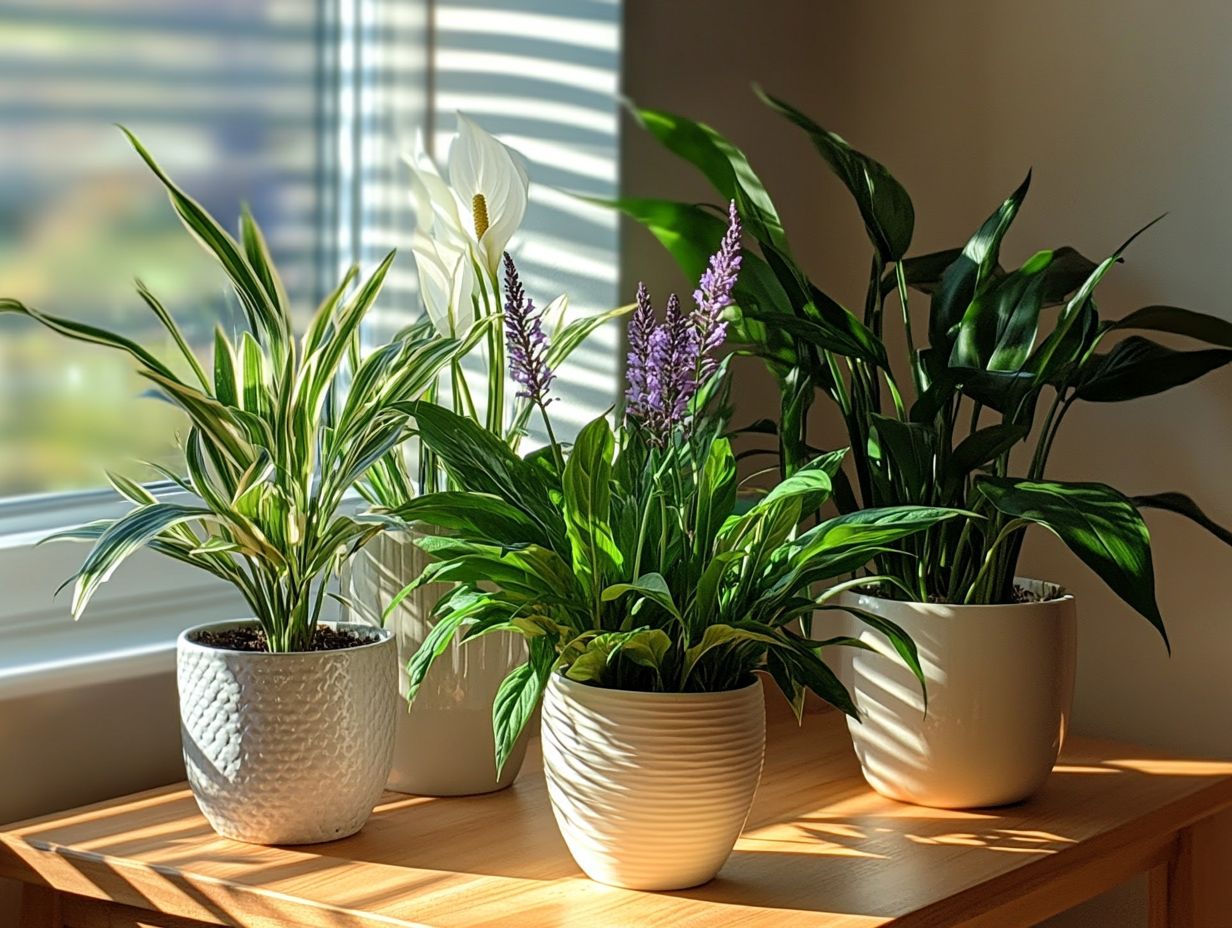
What are the best indoor plants for pest control?
Some of the best indoor plants for pest control include peppermint, lavender, rosemary, basil, catnip, and marigolds, known for their repellent properties.
How do these indoor plants help with pest control?
These plants contain natural compounds and oils, like essential oils from garlic and chili, that act as natural insect repellents, deterring pests from entering your home.
Can these plants be grown indoors without much sunlight?
Yes, many indoor plants thrive in low light. They re perfect for spaces that lack natural sunlight and help reduce bug problems.
Are these plants safe for pets and children?
Yes, these plants are generally safe for pets and kids. However, always check if your specific pet or child is allergic, especially to garlic and chili.
How often do these plants need to be watered?
These plants vary in watering needs. A good rule is to keep the soil slightly moist not soggy so watering once or twice a week typically works well.
Can these plants be used as a sole method of pest control?
These plants help reduce pests but may not eliminate them completely. For the best results, combine these plants with other pest control methods!

